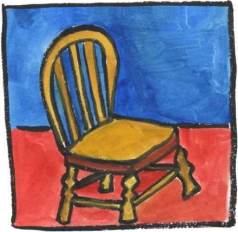For many people sitting and driving — two of the modern world's most common demands on us — are frequently challenging or even painful. As a Feldenkrais teacher I’ve noticed that most of my students who find sitting uncomfortable have the idea that if they could just find the “right” chair and the “right” way to sit in that chair they would be able to engage in sedentary activities for hours without moving.

I used to believe this, too. As a college student I was studying to become a concert pianist. My planned career required me to sit on a piano bench for 3-5 hours a day. I was rarely comfortable, but I hunkered down in the one position I knew, accepted the pain, and got my practice hours in.
Over the years the unnecessary efforts, pain, and inefficiency of my static sitting began to interfere with the freedom of my arms and fingers for playing the piano. I developed repetitive strain injuries that traditional medical approaches couldn’t relieve. Luckily I discovered the Feldenkrais Method, which helped almost instantly when I started to support myself far more dynamically, and began to think about myself as a whole.
Over the 20 years since then I've studied and taught about sitting frequently. Here's a quick overview of principles and specific lessons The Feldenkrais Project has to support your learning.
I designed Driving and Dynamic Sitting - Floor Practice to help you find more comfortable, sustainable sitting, and to intellectually stimulate you about options available in sitting.
 The strategy in that lesson is to divide movements into three planes then lead the students through experiments about how thinking, sensing, and moving in one or more planes can create much more dynamic and creative self-images of pleasurable, sustainable, dynamic sitting, even while confined by a driver’s seat.
The strategy in that lesson is to divide movements into three planes then lead the students through experiments about how thinking, sensing, and moving in one or more planes can create much more dynamic and creative self-images of pleasurable, sustainable, dynamic sitting, even while confined by a driver’s seat.
With these new self-images in mind, and some floor-seated practice at the beginning and end of the lesson, you can experiment more with how you sit in everyday life. I'm seeking to offer options of movement and weight-bearing that give you a lively, curious, dynamic relationship with the seats in your life, instead of a passive, static one.
This lesson focuses on how the use of your whole spine in the sagittal plane (front/back or rounding/arching) affects your movements in the transverse plane (also called the horizontal plane: turning, looking around your horizon).
Driving and Dynamic Sitting - Chair Practice is an entirely chair-seated lesson. In this lesson we explore the sit bones in detail in all three planes of movement, using basic seated Feldenkrais material made popular in Relaxercise, by David and Kaethe Zemach-Bersin and Mark Reese, my favorite Feldenkrais handbook. If you’d like some related lessons with text and illustrations to study after doing my lessons, here’s an Amazon link.
More recently I added the Easier Sitting Workshop, presenting these same principles through different lessons. The workshop is perhaps the best place to start, so I've put it at the beginning of the collection, but you can also begin studying with either Driving and Dynamic Sitting lesson.
You'll likely discover that you have a lot more options available while seated, including in the car. Over time, you can build on your improvements by studying these lessons, paying attention to yourself, and improvising in regular life situations on what you've learned.
Safety first: As stated clearly in the recordings, if you’re working on how you sit and move in your car seat, please practice only when the car is parked.
- Nick Strauss-Klein
When you’re ready to explore the lessons please visit our Easier Sitting collection.
An expanded version of this post is published on the Feldenkrais Guild of North America's website as Building Better Sitting Habits, Even in Your Car.


Very helpful introduction to sitting comfortably.